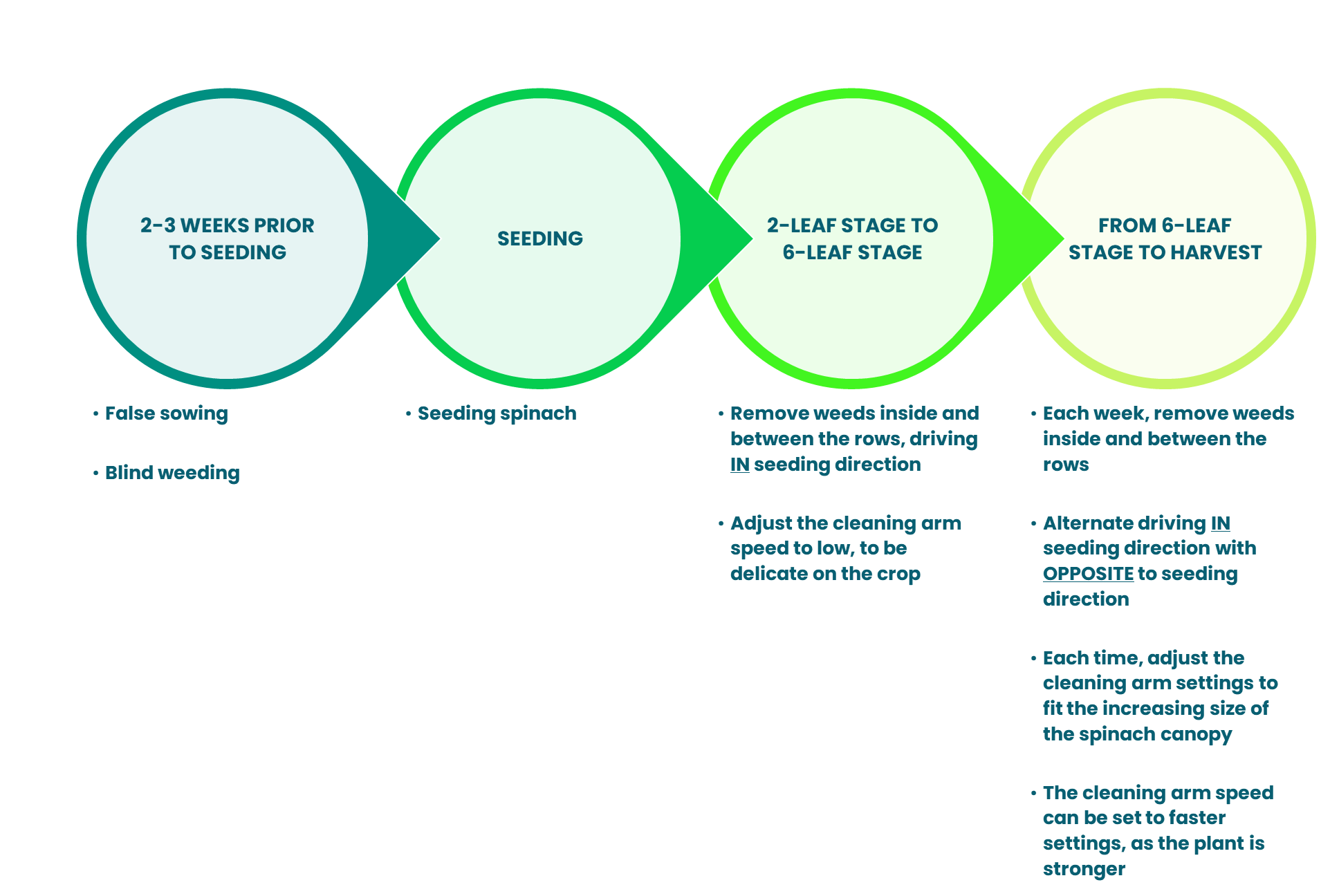SPINACH (Spinacia oleracea L.)
Recommendations for cultivating spinaches and for the use of FarmDroid, to help you shape your own personal success recipe!
1. TEMPERATURE REQUIREMENTS
| Growth stage and temperature | °C |
| Germination | |
| Minimum | 4 |
| Optimal | 15-20 |
| Growth | |
| Lethal | -10 |
| Minimum | 3 |
| Optimal | 15-18 |
| Maximum | 30 |
Depending on the cultivar, spinach is cultivated mainly in the spring or autumn. This crop grows best with relatively cool temperatures, while warm weather (>30°C) and long days will induce flowering of the plants. This causes the plants to redirect their nutrients to seed production, rather than developing new leaves.
2. SOIL REQUIREMENTS
Spinach needs well drained soils with neutral to alkaline pH. Acid soils are as Magnesium and Iron availability would not be negatively affected as in acid soils.
Water stress would cause chlorosis of the leaves and is a condition that must be avoided.
Spinaches can grow in soils with a salinity up to 2.0 mS/cm.
3. SEED-BED PREPARATION
Spinaches have many similarities with red and sugar beets, as they both belong to Chenopodioideae subfamily.
The objective of soil bed preparation is to set the seeds in the best conditions possible for it's germination and future growth. For spinaches, this imply:
- Have a soft surface, keeping in mind that if soil is broken too much, it is likely to cause superficial crusts (depending on the texture) which would limit the germination percentage of spinach seeds, as well as water stagnation
- Flat area or convex shaping of the field, to help draining excess water whenever needed
- Well aerated soil, to both help draining water towards deeper layers, as well as to enhance roots growth
Different tillage strategies can be adopted by farmers, depending on local conditions and the implement availability. General practices for soil cultivation are:
- Plowing at 30-50 cm depth
- In-line ripping or deep cultivating at 70 cm depth, to solve water stagnation and soil compaction (recommended for heavier soils)
- Final preparation to achieve perfect soil consistency. Usually done close to the seeding date
4. SEEDING
Depending on local conditions and climate, seeding is traditionally done:
- In the spring, between March and May, long-day varieties
- In the end of summer, between August and September. Such varieties are more resistant to low temperatures, but are susceptible to flowering when the photoperiod increases
| Seed depth | 1-2 cm |
| In-row distance | 8-15 cm |
| Distance between rows | 20-25 |
| Optimal plant density | 300.000-500.000 plants/ha |
Soil moisture is a key factor for a successful germination. Plan the seeding close to light rainfalls, whenever possible, or irrigate the field if necessary.
5. NUTRITION ASPECTS
A correct fertilization relies primarily upon the total crop needs, to the usage-rate for each element, as well as the nutritional status of the soil after the last harvested crop.
Apart from that, nutritional requirements depend on the whether the product is meant for the fresh market or for processing:
| N (kg/ha) | P2O5 (kg/ha) | K2O (kg/ha) | |
| Fresh market | 80-120 | 80-100 | 100-120 |
| Processing | 150 | 50-60 | 100-120 |
Tips:
- Spinach thrive in soils rich of organic matter, but should be used only mature manure
- Excessive nitrogen fertilization may cause the leaves to build up nitrates (check limits set by National laws)
6. IRRIGATION PRACTICES
Spinach greatly benefit from available water in the soil, but at the same time, has in water stagnation one of its most serious problems. Excessive water can, in fact, can cause chlorosis which would lower yields and in some cases cause the spinach to be unsellable. For these reasons, it is very important to keep into consideration both the watering volumes as well as the watering technique.
It is also important to use a watering technique that won't damage leaves (e.g. sprinkler used at low pressure)
7. WEED MANAGEMENT
Spinach is very sensible to weeds competition and heavily relies on weed control. Moreover, weeds are problematic also from an operation point of view. In fact since the processing spinach are mown at harvest, it is difficult, if not impossible, to separate mechanically the spinach leaves from the weeds.
As a first step to mitigate the competition, it is important to crop the field with fast-growing varieties at higher densities.
General recommendations for the use of FD20 in spinach crop are:
- Do a false sowing followed by blind weeding, if the weather and time allows. It would greatly help to decrease weed pressure in the first stages
- In post-emergence, between 2 to 6-leaf stage, pay attention to be gentle with the spinach seedlings when weeding. It is important not to pull the crop out of the ground
- After 6-leaf until harvest, keep the robot weeding the whole time. Now you can use more aggressive settings for the cleaning arm as the spinach has grown stronger. In any case, keep in mind to adjust the extension percentage of the cleaning arm to the size of the canopy, to prevent any unwanted damage

Weeding, to be effective, should be done when the soil is sufficiently dry to remove/break weeds’ roots. Working depth should be set to shallower settings in first instance. Working deeper does not increase weeding efficacy but increases electricity consumption and parts wear.
8. HARVEST
Spinach has a short cycle and can be harvested when leaves have reached the target size. Depending on climatic conditions, the marketed product and the cultivar, spinach has a growth cycle of approximately:
- 3 to 5 weeks for baby leaves spinaches
- up to 8-12 weeks for processing spinaches
